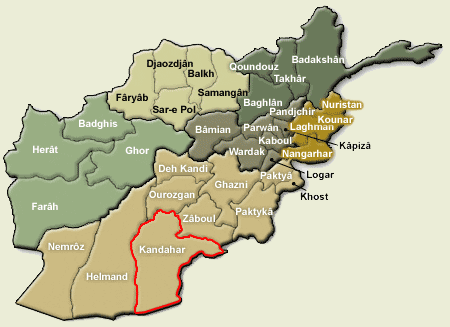

October 2012 to July 2013
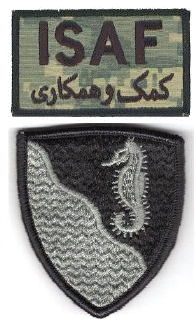 In October 2012 the 20th Engineers arrived at Kandahar Air Field, Afghanistan, under the command of Lt. Col.
Jason Kelly. The battalion was flown from Fort Hood to Kyrgyzstan, then was moved into Afghanistan to participate in Operation Enduring Freedom.
In October 2012 the 20th Engineers arrived at Kandahar Air Field, Afghanistan, under the command of Lt. Col.
Jason Kelly. The battalion was flown from Fort Hood to Kyrgyzstan, then was moved into Afghanistan to participate in Operation Enduring Freedom.
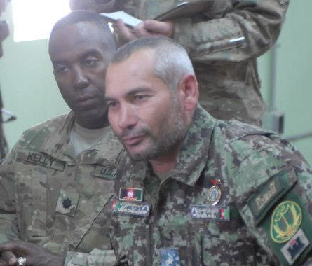 On 11 October 2012 the 20th Engineers, as Task Force Lumberjack, assumed multiple missions
throughout southern Afghanistan: route clearance, construction, and training the Afghan Army. The 20th Engineers were the engineer component of
Regional Command South, part of the
International Security Assistance Force (ISAF), a component of the North Atlantic Treaty Organization (NATO). Task Force Lumberjack commanded multiple engineer companies with up to 800 soldiers at multiple bases across the combined joint operation area, primarily in support of the 3rd Infantry Division and 555th Engineer Brigade.
On 11 October 2012 the 20th Engineers, as Task Force Lumberjack, assumed multiple missions
throughout southern Afghanistan: route clearance, construction, and training the Afghan Army. The 20th Engineers were the engineer component of
Regional Command South, part of the
International Security Assistance Force (ISAF), a component of the North Atlantic Treaty Organization (NATO). Task Force Lumberjack commanded multiple engineer companies with up to 800 soldiers at multiple bases across the combined joint operation area, primarily in support of the 3rd Infantry Division and 555th Engineer Brigade.
As
the lone multi-functional engineer effects element within Regional Command South, Task Force Lumberjack supported the establishment
and development of the Afghanistan Nation Army (ANA) engineers through partnership and combined
action operations, provided assured mobility along theater controlled routes and freedom of movement
for three maneuver brigade combat teams through route clearance and road construction, and
coordinated, managed, and executed all horizontal and vertical construction projects. Throughout the deployment, the soldiers of the 20th Engineers enabled other units throughout southern Afghanistan to conduct operations
in a much safer environment. Task Force Lumberjack conducted 1,234 missions, traveling over 110,500 kilometers, finding
& clearing more than 95 improvised explosive devices and unexploded ordnance, and completing approximately 56 construction projects.
The task organization of Task Force Lumberjack in Afghanistan was dynamic as engineer companies (both active duty and reserve component) were deployed into the country, then later redeployed back to the United States. The 510th Engineer Company and 584th Engineer Company, normally assigned to the 20th Engineers at Fort Hood, deployed
separately from the battalion headquarters and were never part of Task Force Lumberjack in Afghanistan.
.
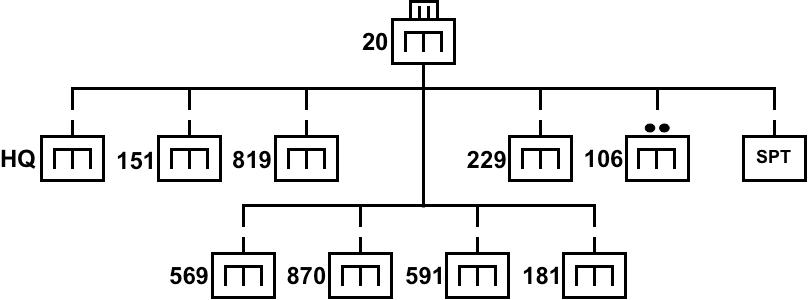
The primary mission of the 151st Engineer Company (Route Clearance), North Carolina Army National Guard, was to conduct route clearance to ensure freedom of mobility in Zabul Province from 24 August 2012 to 24 April 2013. The company conducted over 80 directed operations and 300 Counter Improvised Explosive Device reconnaissance missions totaling more than 20,000 kilometers traveled while successfully disarming 20 Improvised Explosive Devices. The company conducted nine major named operations supporting Special Operations Task Force - Southeast and Romanian Forces. The 151st trained and mentored the Afghan 2nd Mobile Strike Force and the 205th Engineer Company on combat engineer and route clearance tactics, techniques, and procedures, which included several combined armed route clearance missions. The maintained maintained an operational readiness rate of 85% on the route clearance equipment.
The 181st Engineer Company (Vertical Construction), Massachusetts Army National Guard, conducted construction projects valued in excess of $26,000,000 throughout the region. The 181st was task organized with one horizontal construction platoon of the 299th Engineer Company, and detached one vertical construction platoon to the 299th. The company's work on the Apache construction projects enabled the base reconsolidation and closure of multiple locations within Zabul Province. The unit trained heavy engineer equipment operators from the Afghan army in basic maintenance and horizontal construction operations. The 181st managed and retrograde of the unit's Class IV yard located at FOB Walton. The company analyzed and produced 287 detailed route packages in direct support of 125 combat and logistical patrols of over 15,000 kilometers, providing vital reporting information to higher, subordinate and adjacent units throughout the operating environment while maintaining an operational readiness rate of just over 90%.
The 229th Engineer Company (Horizontal Construction), Wisconsin Army National Guard, with one platoon detached to the 181st Engineer company and one vertical construction platoon attached from the 181st, and with the attached 106th Engineer Detachment (Quarry) completed engineer construction operations to provide mobility, counter mobility and survivability for all forces throughout Regional Command South. The company's expansion of forward operating base Mescall enabled the base closure and realignment of Zabul Province. The unit also focused on advising and evaluating Afghan National Army engineers to ensure they would be capable to sustain operations after the drawdown of coalition forces. The 229th completed several joint construction projects in partnership with ANA including Operationo Southern Fist III and Route Vesuvius. The 229th completed 19 horizontal construction missions and seven vertical construction missions, as well as 120 tactical movements over 18,000 kilometers. The 229th established freedom of movement for coalition forces throughout Kandahar Province through the repair and construction of critical roadways and execution of combined arms breaching operations. The 229th increased force protection by constructing check points, entry control points, and fighting positions and improved the quality of life for Soldiers through the completion of forward operating base expansions and dining facility construction and upgrade.
The 569th Engineer Company (Sapper) (normally based at Fort Carson), performed area and route clearance in the Spin Boldak District up until it transferred its mission to the 591st Engineer Company in February 2013. It conducted 360 missions that cleared over 30,000 kilometers of road and disposed of 286 improvised explosive devices. The company earned a Valorous Unit Award for its exemplary performance.
The 591st Engineer Company (Sapper) (normally based at Fort Campbell), performed route clearance in the Spin Boldak District from 15 January 2013 - 15 October 2013 as part of Task Force Lumberjack, in direct support of 4th Brigade Combat Team (Task Force Dragoon), 2nd Infantry Division. The 591st operated as a route clearance company comprised of 83 Soldiers and 37 pieces of rolling stock worth more than $40,000,000. The company conducted more than 300 route clearance combat patrols with over 250 unilateral operations. The 591st cleared more than 15,000 kilometers along unimproved routes and logged more than 1,500 mission hours, resulting in the reduction of more than 75 improvised explosive devices and pieces of unexploded ordnance, which ensured the freedom of movement to coalition forces throughout the Spin Boldak district.
The 870th Engineer Company (Sapper), Florida Army National Guard, performed route clearance in Zabul Province, Afghanistan from 06 August 2012 - 24 April 2013 as part of Task Force Lumberjack and in direct support of 1st Brigade Combat Team (Task Force Raider), 3rd Infantry Division. The 870th deployed as a route clearance company comprised of 95 Soldiers and 53 pieces of rolling stock worth more than $35,000,000. The 870th conducted more than 230 route clearance combat patrols clearing more than 9,500 kilometers along main supply routes, found and cleared more than 60 IEDs and UX0s, which ensured the freedom of movement to local national and coalition forces throughout Zabul Province. The company was routinely in direct combat operations, esulting in the awarding of 67 combat action badges, three combat medic badges, one purple heart and the company combat action streamer. The 870th partnered with and trained the Afghan Route Clearance Company of the 205th Mobile Strike Force, improving their mission readiness and effectiveness.
The 819th Engineer Company (Sapper), Arizona Army National Guard, relieved the 870th Engineer Company and performed route clearance in Zabul Province, Afghanistan from 06
August 2012 - 24 April 2013 as part of Task Force Lumberjack and in direct support of 1st Brigade Combat Team (Task Force Raider), 3rd Infantry Division.
An article from the Killen Daily Herald, 27 February 2013:
The 20th Engineer Battalion is making a positive impact on the future of Afghanistan, said Lt. Col. Jason Kelly, battalion commander.
"We are playing an important part in the Afghan end game. Soldiers understand that and they are giving nothing but their best every day," Kelly said during a phone interview from Kandahar Airfield on Friday.
The "Lumberjack" Battalion, which falls under Fort Hood's 36th Engineer Brigade, is five months through a nine-month rotation in Afghanistan's Regional Command-South.
The battalion deployed as Task Force Lumberjack in October with its own headquarters and support companies. The other five companies to fall under Lumberjack are four Army National Guard units from Massachusetts, Wisconsin, North Carolina and Florida, and one active-duty sapper company from Fort Campbell, Ky.
"We did a lot of work up front to ensure that we created what I refer to as a smart and healthy organization," Kelly said. "Smart as in doing the right things the right way, and healthy in the sense that it is void of confusion, misunderstanding and miscommunication."
Two companies that fall under the battalion in garrison were deployed to the same region, but under different battalions. Both recently returned to Fort Hood.
"I would come into meetings and listen in to folks talk about my companies," Kelly said. "I was really proud to hear how the companies we were responsible for training were doing."
Play key role
As the only multi-functional engineer battalion in the region, the 20th Engineers not only perform route clearance, but also a construction mission and play a major role in the development of the Afghan National Army engineers.
In its previous Afghanistan deployment, Kelly said the unit focused only on route clearance. The deployment before that in Iraq, was strictly construction.
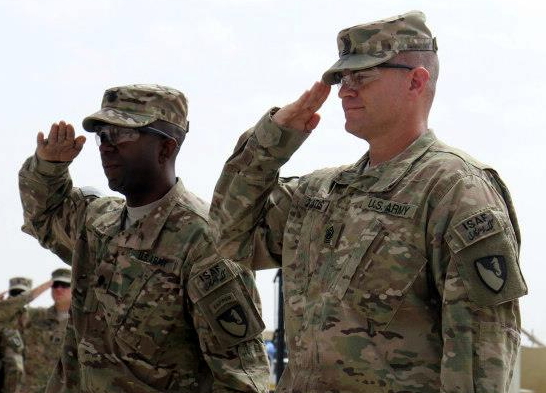
Battalion Commander, Lt. Col. Jason Kelly - and Battalion Command Sergeant Major Joseph Zokaitis
On a given day, Lumberjack soldiers can be found as far north as Tarin Kot down to the Pakistan border, meaning soldiers are expected to travel long distances across unknown territory.
"We have established a reputation as a can-do organization and one that Regional Command-South comes to and anticipates and expects superior performance," Kelly said. "Our mission, in terms of route clearance, is to provide freedom in movement in support of expeditionary logistics."
Kelly said the unit has encountered more than 300 roadside bomb events, and while there have been injuries, techniques, equipment and training have been key to staying safe.
"Certainly, we are without doubt in harm's way," he said.
Support mission
The Lumberjack construction mission has often been in support of the ongoing base closure and realignment initiative, which will help U.S. forces pull out of Afghanistan by 2014, as mandated by President Barack Obama.
"With the end of this mission and the transition to Afghan independence looming, some places you have to increase capacity and others we're either transferring or closing," Kelly said. "That effort requires engineers to do their part. So we have done a great deal of construction to increase capacity and some locations and reduce it at others."
This mission also includes early stages of retrograde operations. The battalion must identify any excess equipment or material and ensuring it is either consumed, reused, reduced or re-entered into the Army system.
Training Afghan soldiers has been one of the most rewarding aspects of the mission, Kelly said.
"We have established a symbiotic relationship with the Afghans and are conducting missions together. We are well on our way to stepping back as they step forward," Kelly said. "But transitions are tough and I think we are in a period of transition. ... It's not about us. We're not being measured by what we do. It's about what the Afghans are doing."
While days can be long and the work difficult, the battalion takes the 20th day of each month to celebrate "Lumberjack Day." Soldiers can barbecue and relax a bit for the day. Kelly also uses this time to hand out awards and conduct re-enlistments.
As much as soldiers anticipate Lumberjack Day, it's their redeployment to Fort Hood they are counting down toward.
"I would say that families of the Lumberjack Battalion ... can and should be proud of what the soldiers are doing," Kelly said. "They are without a doubt making a difference and we look forward to reuniting with our loved ones on Cameron Field in a few months."
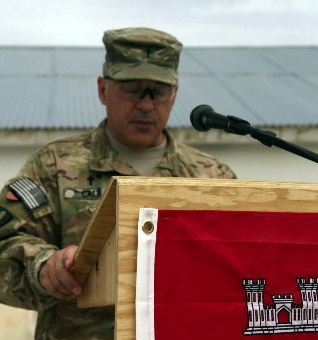
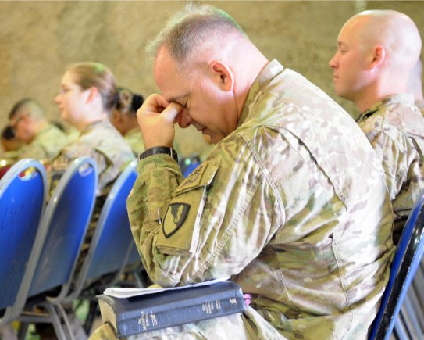
Battalion Chaplain, Captain William Cale
At left, at the "transfer of authority" ceremony for the 870th and 819th Engineer Companies
At right, at Easter holy day services
The 20th Engineers had earned yet another campaign streamer, Afghanistan - Consolidation II.

